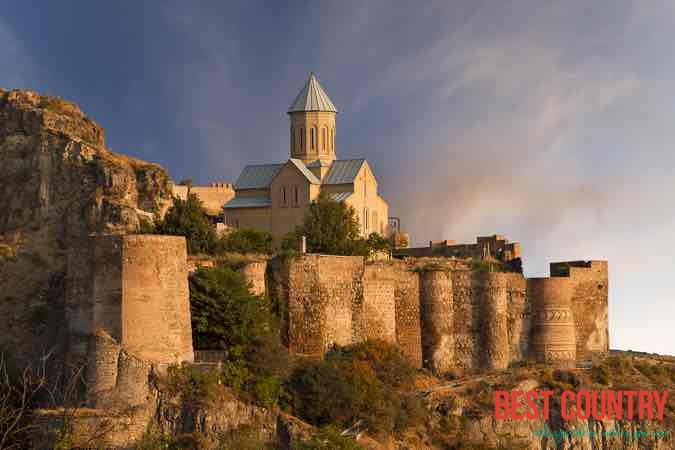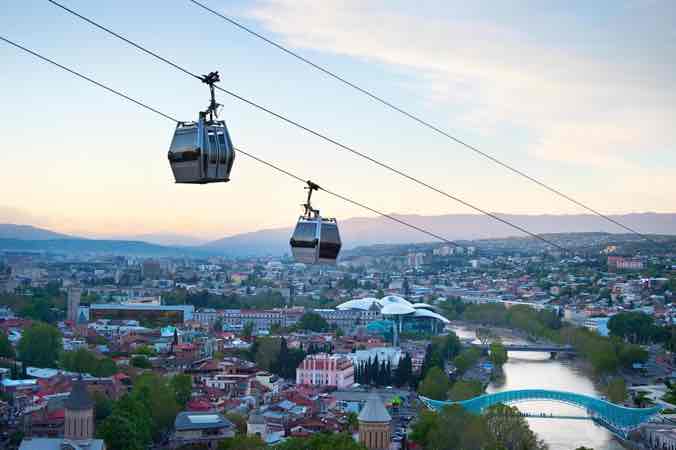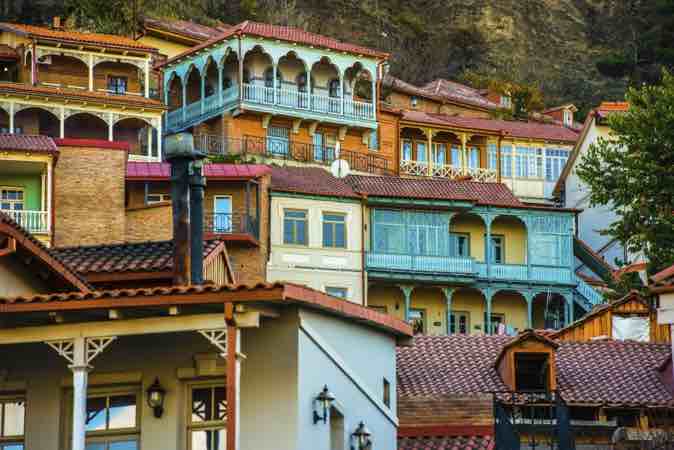Most fun & popular experiences in Tbilisi
Narikala Fortress
Once a Persian citadel, the ancient Narikala Fortress dominates the Tbilisi skyline. Established in the fourth century, it was expanded in the seventh, 16th, and 17th centuries, before much of it was destroyed in an explosion in 1827. The view from the fortress is one of the best in the Georgian capital.

Where is the Narikala Fortress?
Narikala is located on a hill of the Sololaki Range, between the sulfur baths and the Tbilisi Botanical Garden.
Tbilisi Aerial Tramway
Opened in 2012, Tbilisi’s aerial tramway connects Rike Park on the left bank of the Mtkvari river to the Narikala Fortress. Savor 360-degree views of the Georgian capital while the cable car whisks you to the top of Sololaki Hill.

Tbilisi Old Town (Dzveli Tbilisi)
Despite having undergone countless reconstructions over the centuries, Tbilisi’s Old Town has somehow retained its picturesque charm. With a colorful blend of Eastern and Western styles, the district’s cobblestone streets, ancient landmarks, and beautiful balconies draw architecture, history, and culture enthusiasts from around the world.

Tbilisi Funicular
One of the world’s steepest funiculars, the Tbilisi Funicular connects the Georgian capital with the Mtatsminda Plateau. Built in 1905 and reopened in 2012 following renovations, the funicular connects Tbilisi with the mountaintop Mtatsminda Park, which comprises a restaurant complex, an amusement park, and a TV tower.
Metekhi Church
Situated on the left bank of the Mtkvari River, Metekhi Church is one of Tbilisi’s key religious landmarks. First built in the 13th century, and located where ancient Georgian ruler Vakhtang I Gorgasali was said to have established Tbilisi in the 5th century, the church is a popular destination among history buffs and religious devotees.
Tbilisi Holy Trinity Cathedral (Tsminda Sameba)
The tallest church in Tbilisi, the Holy Trinity Cathedral (Tsminda Sameba) is an unmissable feature of the Tbilisi skyline: its golden dome rises out from Elia Hill and is visible from almost any point in the city. The stunning structure is part of a complex that includes a monastery, theology school, and nine chapels (including five underground).
Georgian National Museum (Saqartvelos Erovnuli Muzeumi)
The city of Tbilisi is rich with history, but travelers looking to gain a deeper understanding of the nation’s dynamic past should pay a visit to the Georgian National Museum (Saqartvelos Erovnuli Muzeumi), where impressive galleries are lined with the art and artifacts of this diverse nation, dating back to the 8th millennium BC.
Travelers say the well-organized museum provides vital insight into Georgia’s history, including its existence under soviet rule. The treasury exhibit in the museum’s basement showcases jewels dating back more than 2,000 years and the armory section displays some impressive pieces from World War II. Though the museum is small by international standards, visitors agree it packs thousands of years of history into a compact space. Most of the material isn’t translated, so travelers who want to get the most from this experience may want to opt for a guided tour in one of four languages offered.
Mtatsminda Park
Mtatsminda Park was once the third-most-visited entertainment center in the USSR. Today, the family-friendly landscaped park—with its carousels, waterslides, roller coaster, and Ferris wheel—remains a popular destination for travelers and locals looking for a day of fun and leisure.
Château Mukhrani
Founded in the late 19th century by Prince Ivane Mukhranbatoni, the Château Mukhrani is a winery and castle located in Mukhrani village, just outside of Tbilisi. Mukhrani wines received international acclaim from the beginning and the winery was one of the exclusive suppliers to the Russian Imperial Court. The castle and gardens were once a cultural center for the Georgian elite and Russian royalty. Château Mukhrani was abandoned and nearly destroyed during Soviet times, but in 2002 plans began to restore the estate to its former glory and to revive the winery.
Since 2007, Château Mukhrani has once again been producing wine harvested in its own vineyards. The wine cellar has also been rebuilt according to its original design and now holds more than 60,000 barrels of wine. Today, visitors can tour the restored castle, gardens and wine cellar; sample Mukhrani wines and Georgian cuisine; and try their hand at traditional bread baking, churchkhela making or chacha distillation.
Open Air Museum of Ethnography (Etnografiuli Muzeumi)
Set on a hill overlooking Tbilisi’s Vake District, the Open Air Museum of Ethnography (Etnografiuli Muzeumi) provides examples of folk architecture and crafts from around Georgia. Named after Giorgi Chitaia, a Georgian ethnographer who founded the museum in 1966, it features 70 buildings spread across 52 hectares of land. The exhibits are divided into nearly a dozen areas, each one representing a different part of Georgian ethnology.
Among the buildings that visitors will see are traditional, flat-roofed stone houses from eastern Georgia, watch towers from mountainous regions like Khevsureti and Svaneti, wooden houses with gable roofs from western Georgia, a Kakhetian wintery and a Kartlian water mill. Within many buildings, you will find displays of traditional costumes, ceramics, furniture and other household items specific to the region.
The museum also hosts a folk culture festival each summer and, in addition to the ethnographic exhibits, it offers superb views around Tbilisi. It also features the Rachasubani restaurant, a good place to try traditional Georgian cuisine.